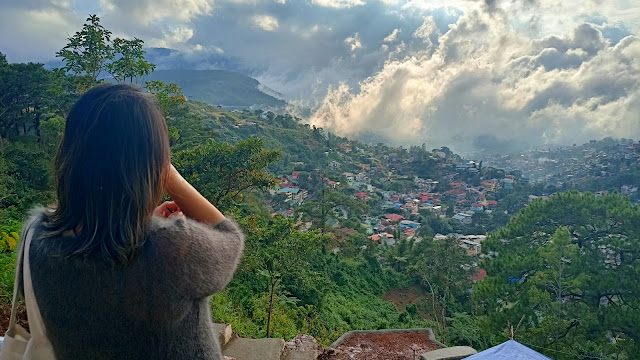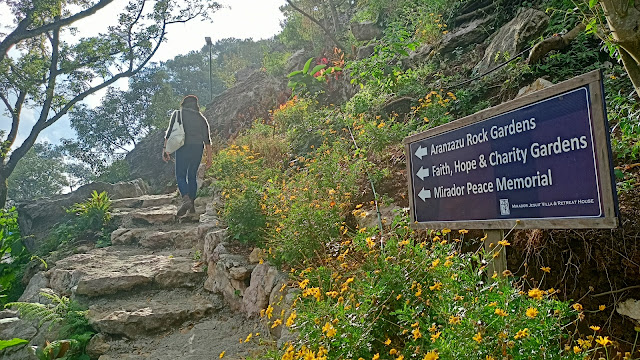When I first visited Mirador Hill in October 2020 just when the city was starting to loosen up with Covid restrictions, it was still known to most as the Mirador Jesuit Villa and Retreat House. At that time, there were already plans to create a bamboo forest and an eco-park surrounding this haven of tranquility.
After the war in 1945, Jesuits from other parts of Asia went here to study because Jesuit teachers would often stay here during the summer. The current retreat house — the third one built by the Jesuits in the City of Pines — was designed by Gines Rivera, the same architect who designed the Administration Building of Ateneo de Manila, in 1952.
 |
| The Mirador Jesuit Villa Retreat House was founded in 1907 |
In 1876, Don Manuel Scheidnagel, the governor politico-militar of Benguet, gave the hill its current name, El Mirador, after the Spanish word for "lookout" or "vantage point," because of the breathtaking view it provided of Lingayen Gulf, La Union, and the South China Sea from its peak. Fr. Miguel Roces, rector of Manila's Ateneo Municipal, proposed establishing a sanatorium for Jesuits in the province of Benguet in 1890. For Jesuits, the cooler weather in the highlands was seen to be a panacea to the energy-sapping humidity of Manila.
Idyllic Place for Meditation
We were told that Mirador is frequently used by the Jesuits for their annual retreats and the Catholic Bishops Conference of the Philippines (CBCP) held their discussions here a few times, as well as hosting random individuals seeking to rediscover their spirituality.
 |
| The small chapel inside the retreat house |
Walking across the grounds brought up memories of a high school retreat I had undertaken. The exact location of our Baguio retreat house has eluded my memory to this day. What I recall are the parallels between that and Mirador, particularly the sense of seclusion despite being located in a densely populated city.
 |
| The common area inside the retreat house |
There's a beautiful view of the Benguet mountains from the common area, as well as a tiny chapel, private prayer rooms, and a variety of rooms to choose from for sleeping and relaxing. I can see people coming here to enjoy the peacefulness of nature and the pleasant temperature.
 |
| I'm guessing this is a prayer / sharing room |
If you do decide to venture out of Mirador Retreat House, you'll still find plenty of beautiful natural areas in which to immerse yourself in silent contemplation and really embrace your spirituality.
Mirador Heritage and
Eco-Spirituality Park
Fast forward to December 2021 and I’m back again in Baguio City, this time with my friend Missy. On our second day we made sure of going to Mirador Hill since I am curious to see how the Heritage and Eco-Spirituality Park compliments the historic Retreat House.
 |
| The Arashiyama Bamboo Grove |
Worried that the swarm of tourists snapping Instagram images on the newly manicured bamboo forest would intrude to the hilltop’s serene vibe, I eventually felt that it wasn’t the case.
 |
| With Missy |
First, the park spreads 5 hectares divided into different sections and attractions, thus providing a place for anyone to be alone in silence and prayer.
At first, the decision to landscape a bamboo grove and construct a Torii gate, which is a traditional Japanese gateway emblem, seemed odd to me. Now that I learned what it symbolizes is related to the history of Mirador Hill, I can't help but appreciate its existence there—and also because it makes for a striking photographic subject foregrounding the sweeping views of the mountains.
 |
| Despite drawing lots of visitors, you can easily find a quiet place to reflect |
Facing the direction towards the Lingayen Gulf, the Torii gate, a fixture in Shinto shrines in Japan, symbolizes the transitioning of energies from ordinary to a sacred space. A fitting spiritual belief considering Baguio and Japan is intertwined by the horrible events of World War II.
 |
| Gorgeous view from the hilltop |
The bell that hangs on the Torii gate itself was from an unexploded bomb meant to kill Japanese soldiers who took refuge within the walls of the Jesuit’s Monastery near the end of the war.
 |
| This Torii gate is one of Mirador's most popular attraction |
“From the mundane suffering of the war to a sacred place of miracle and humanity”, as if the Torii gate is meant to convey.
 |
| We were laughing because there was a construction going on nearby and the drilling noise was ruining the peace lol |
While the presence of tourists may make the once secluded Mirador Hill feel like any other Baguio landmarks, the Zen mood that has existed for so long on this hilltop spot of seclusion persists. Most especially to the ones who appreciate time with nature as moment well spent, will surely want to go back, for a lengthy reflection time perhaps. Count me as among those who would want my Mirador Hill experience to be more than just a walk in the park.























